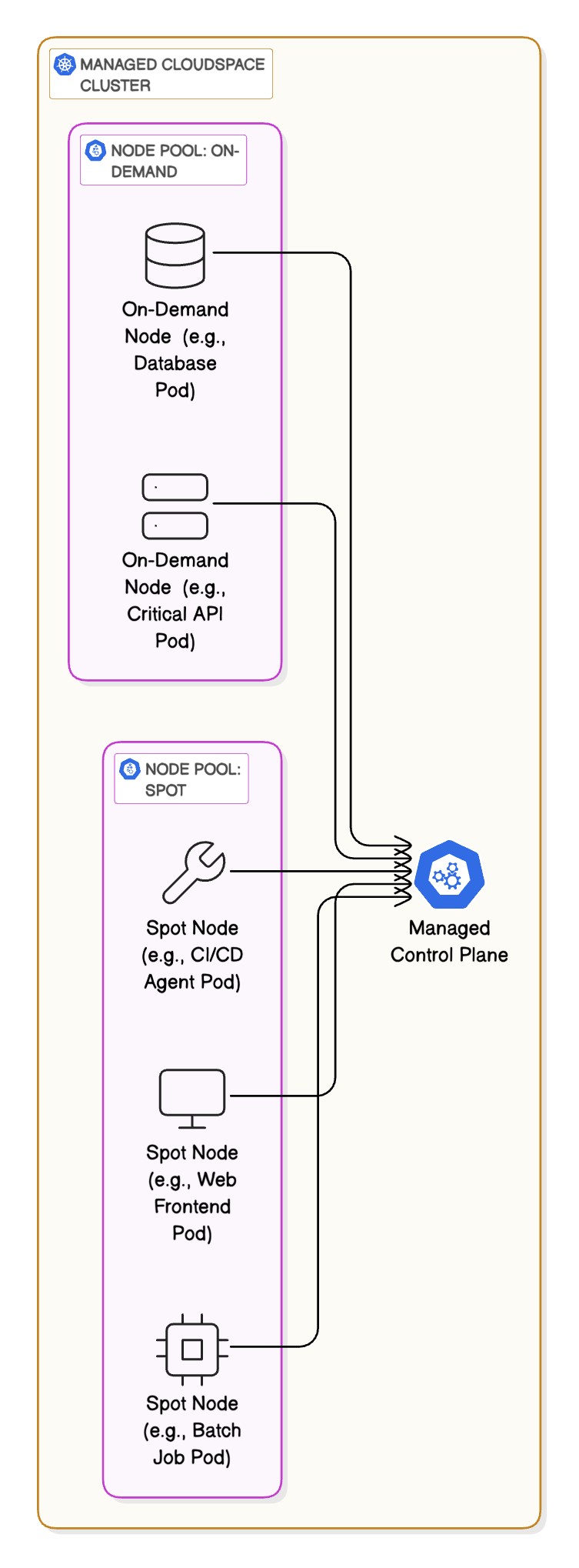Spot vs. On-Demand Servers: Choosing the Right Node Type
Rackspace Spot offers two distinct types of worker nodes for your Kubernetes Cloudspace: Spot and On-Demand. Understanding their differences is key to optimizing both cost and reliability for your applications. Both Spot and On-Demand utilize the same Server Classes the difference is how the server pools are managed.
At a Glance Comparison
| Feature | Spot Instances | On-Demand Instances |
|---|---|---|
| Pricing | Dynamic (Market Auction) | Fixed (Monthly Rate) |
| Cost Savings | Significant (Up to 90%) | Predictable Costs |
| Availability | Uses Spare Capacity | Guaranteed Resources |
| Pre-emption | Possible (if market price > bid) | None |
| Stability | Potential interruptions if bid falls under market prices | Stable, guaranteed |
| Ideal For | Fault-tolerant, stateless, flexible workloads, batch, CI/CD | Critical databases, stateful apps |
Spot Instances: Maximizing Cost Savings
Spot Instances leverage Rackspace's spare compute capacity, offered through a dynamic open market auction.
Benefits:
- Major Cost Reduction: The primary driver for using Spot is the potential for dramatic cost savings compared to On-Demand pricing. This makes running large-scale or non-critical workloads much more affordable.
- Access to Powerful Hardware: Obtain access to various compute, memory, or even GPU-optimized instances at significantly lower prices.
Key Consideration: Pre-emption
The trade-off for the low cost is pre-emption. Because Spot uses spare capacity, your instance can be terminated if:
- The current market price for that instance type rises above your maximum bid.
- The underlying capacity is needed elsewhere.
This means Spot Instances are best suited for applications designed to handle interruptions gracefully. (See Pre-emption Explained and Bidding Best Practices).
On-Demand Instances: Ensuring Stability and Predictability
On-Demand Instances are the traditional cloud server model.
Benefits:
- Guaranteed Availability: You have dedicated access to the resources you pay for; they won't be pre-empted.
- Predictable Billing: Costs are fixed on a monthly basis, making budgeting straightforward.
- Maximum Stability: Ideal for workloads that cannot tolerate interruptions, such as primary databases, stateful applications, or critical core services.
Consideration:
- Higher Cost: The guarantee of stability comes at a standard market price, which is significantly higher than potential Spot prices.
The Power of Hybrid Cloudspaces: Best of Both Worlds
One of the most powerful features of Rackspace Spot is the ability to mix Spot and On-Demand node pools within the same Cloudspace cluster. This allows you to tailor your infrastructure precisely to your application's needs, balancing cost savings with reliability.

Common Hybrid Strategies:
- Core Services on On-Demand, Scalable Layers on Spot: Run essential components like databases, message queues, or critical backend APIs on stable On-Demand nodes. Use cost-effective Spot nodes for stateless frontends, worker pools, or batch processing that can scale horizontally and tolerate potential node loss.
- Production on On-Demand, Dev/Test/Staging on Spot: Guarantee stability for production environments while drastically reducing costs for non-production environments.
- Baseline on On-Demand, Bursting on Spot: Handle consistent load with On-Demand nodes, but use Spot nodes to handle temporary spikes in traffic or computation needs at a lower cost.
How to Choose
Consider the following for each component of your application:
- Tolerance for Interruption: Can this workload handle being stopped and potentially restarted on a different node? (If yes, consider Spot. If no, use On-Demand).
- Statefulness: Does it store critical data locally that is difficult to reconstruct? (If yes, consider On-Demand or ensure robust state management/replication if using Spot).
- Criticality: Is this component essential for the core functionality of your application? (If yes, On-Demand provides peace of mind).
- Cost Sensitivity: Is minimizing cost a primary goal for this specific workload? (If yes, Spot is attractive).
By strategically using Spot, On-Demand, or a hybrid approach, you can build robust, scalable, and cost-effective Kubernetes applications on Rackspace Spot.
Refer back to Create a Cloudspace Cluster or Adding Servers for details on adding Spot or On-Demand server pools.